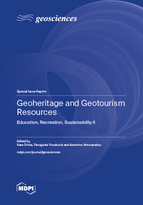Geoheritage and Geotourism Resources: Education, Recreation, Sustainability II
A special issue of Geosciences (ISSN 2076-3263). This special issue belongs to the section "Geoheritage, Geoparks and Geotourism".
Deadline for manuscript submissions: closed (30 June 2023) | Viewed by 31412
Special Issue Editors
Interests: palaeoecology; sedimentology; palaeoenvironment; geoheritage; geotourism; geoconservation; geoeducation
Special Issues, Collections and Topics in MDPI journals
Interests: ore minerals; critical metals; magmatic-hydrothermal ore deposits; mineralogy of hydrothermal alterations in porphyry-epithermal systems; mineralogy and genesis of gemstones
Special Issues, Collections and Topics in MDPI journals
Interests: paleoclimatology; paleoceanographic proxies; micropaleontology; integrated stratigraphy; marine geology; ocean dynamics; sea-level changes; marginal seas; astronomical frequencies in paleoclimates; extreme geological events
Special Issues, Collections and Topics in MDPI journals
Special Issue Information
Dear Colleagues,
In recent years, interest in the geoenvironment has steadily increased. Concepts such as "geosites," "geoparks," and "geodiversity" are intrinsically linked to several areas' newfound local economic and cultural growth. Significant geosites are recognized globally for their geopark activity and benefit from the exchange of information, skills, experience, and personnel among geoparks. Geotourism is a type of tourism that allows visitors to learn about the geological features of the areas they visit, as well as other natural and human resources. Geoeducation is at the heart of geoparks' interest and operation, as they are regarded as ideal locations for educational activities.
In this second volume, we aim to bring together a collection of papers that demonstrate the importance of geoeducation for the promotion and preservation of geological heritage and geoethical values. In addition to research articles covering all possible geological heritage approaches, we also encourage the submission of papers that focus on new cases and highlight current challenges or knowledge gaps, as well as long-term review articles.
Although there is a wide range of topics that encompass this field, some relevant examples include:
- Scientific studies of geoheritage presenting geosites occurring in different geological and geomorphological contexts;
- Techniques for the enhancement of geoheritage;
- Significance of geoheritage in human life;
- Geosciences education for sustainability;
- Educational programmes;
- Sustainable geotourism, which highlight problems connected with the management of geological heritage;
- Sustainable use of natural and cultural heritage and resources;
- Valorization of geoheritage for sustainable and innovative tourism development.
Prof. Dr. Hara Drinia
Prof. Dr. Panagiotis Voudouris
Prof. Dr. Assimina Antonarakou
Guest Editors
Manuscript Submission Information
Manuscripts should be submitted online at www.mdpi.com by registering and logging in to this website. Once you are registered, click here to go to the submission form. Manuscripts can be submitted until the deadline. All submissions that pass pre-check are peer-reviewed. Accepted papers will be published continuously in the journal (as soon as accepted) and will be listed together on the special issue website. Research articles, review articles as well as short communications are invited. For planned papers, a title and short abstract (about 100 words) can be sent to the Editorial Office for announcement on this website.
Submitted manuscripts should not have been published previously, nor be under consideration for publication elsewhere (except conference proceedings papers). All manuscripts are thoroughly refereed through a single-blind peer-review process. A guide for authors and other relevant information for submission of manuscripts is available on the Instructions for Authors page. Geosciences is an international peer-reviewed open access monthly journal published by MDPI.
Please visit the Instructions for Authors page before submitting a manuscript. The Article Processing Charge (APC) for publication in this open access journal is 1800 CHF (Swiss Francs). Submitted papers should be well formatted and use good English. Authors may use MDPI's English editing service prior to publication or during author revisions.
Keywords
- geoheritage
- geoconservation
- geosite
- geotope
- geoeducation
- geotoursim
- sustainability
- geopark
- public awareness








